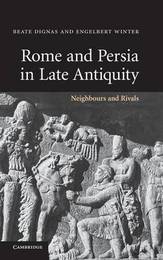
|
Rome and Persia in Late Antiquity: Neighbours and Rivals
Hardback
Main Details
| Title |
Rome and Persia in Late Antiquity: Neighbours and Rivals
|
| Authors and Contributors |
By (author) Beate Dignas
|
|
By (author) Engelbert Winter
|
| Physical Properties |
| Format:Hardback | | Pages:364 | | Dimensions(mm): Height 229,Width 152 |
|
| Category/Genre | World history - BCE to c 500 CE |
|---|
| ISBN/Barcode |
9780521849258
|
| Classifications | Dewey:937.06 |
|---|
| Audience | | Tertiary Education (US: College) | | Professional & Vocational | |
|---|
| Illustrations |
14 Maps; 15 Halftones, unspecified; 3 Line drawings, unspecified
|
|
Publishing Details |
| Publisher |
Cambridge University Press
|
| Imprint |
Cambridge University Press
|
| Publication Date |
13 September 2007 |
| Publication Country |
United Kingdom
|
Description
The foundation of the Sasanian Empire in Persia in AD 224 established a formidable new power on the Roman Empire's eastern frontier, and relations over the next four centuries proved turbulent. This book provides a chronological narrative of their relationship, supported by a substantial collection of translated sources illustrating structural patterns. The political goals of the two sides, their military confrontations and their diplomatic solutions are discussed, as well as the common interests between the two powers. Special attention is given to the situation of Arabia and Armenia, to economic aspects, the protection of the frontiers, the religious life in both empires and the channels of communication between East and West. Considerable attention is also paid to exploring the role played by the Sasanians in the history of the ancient Near East. The book will prove invaluable for students and non-specialists interested in late antiquity and early Byzantium.
Author Biography
Beate Dignas is Fellow and Tutor in Ancient History at Somerville College, Oxford. Engelbert Winter is Professor of Ancient History at the University of Munster.
Reviews'... this is an excellent textbook introduction to Roman-Persian relations of the Late Antique period for specialist and non-specialist readers alike. It will, undoubtedly, prove popular in introductory and survey courses. The book's main virtue is that it makes accessible a wide range of sources in translation and does so in a very readable and user-friendly manner with repeated cross-references between the two parts of the book.' Bulletin of the School of Oriental and African Studies
|